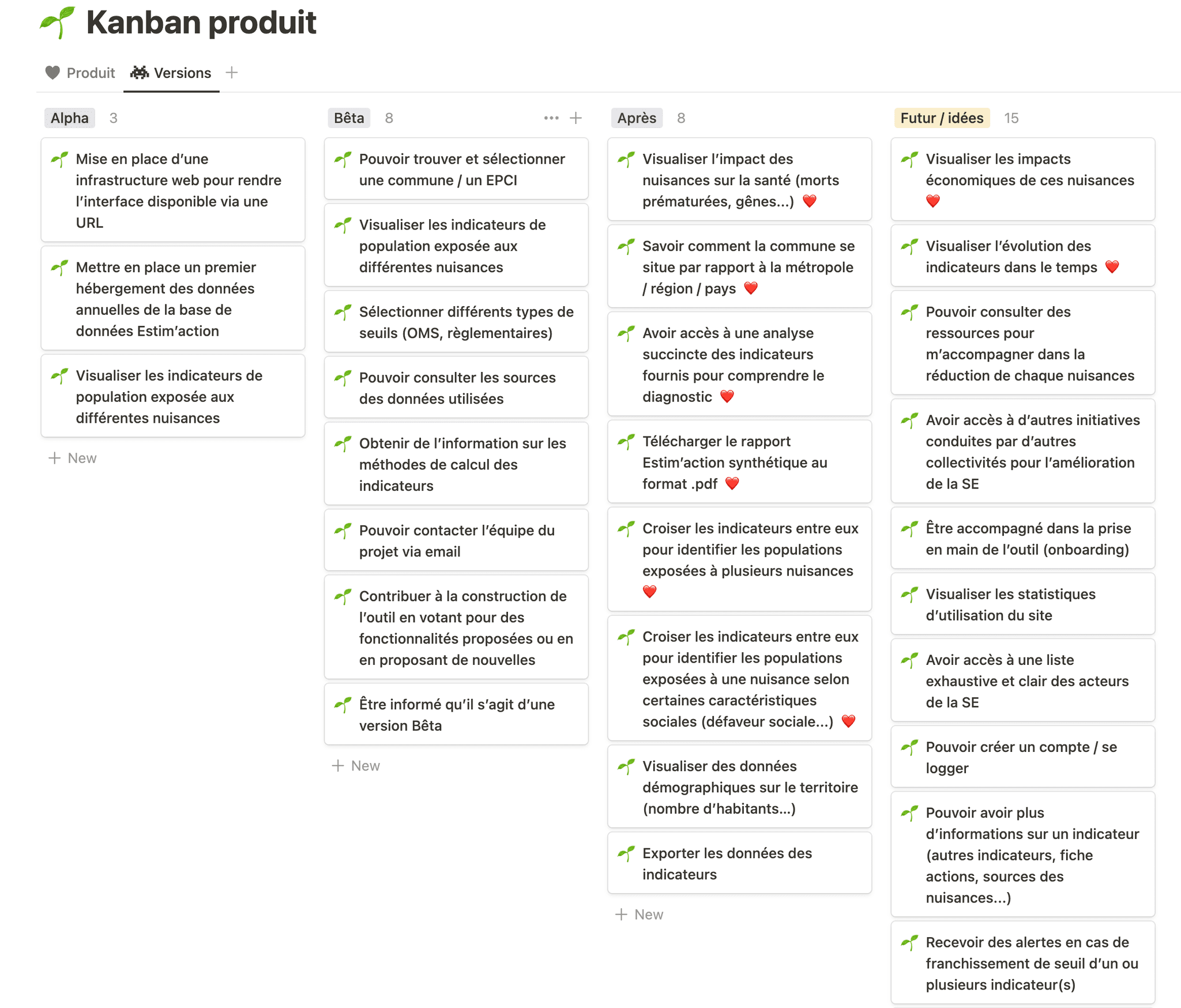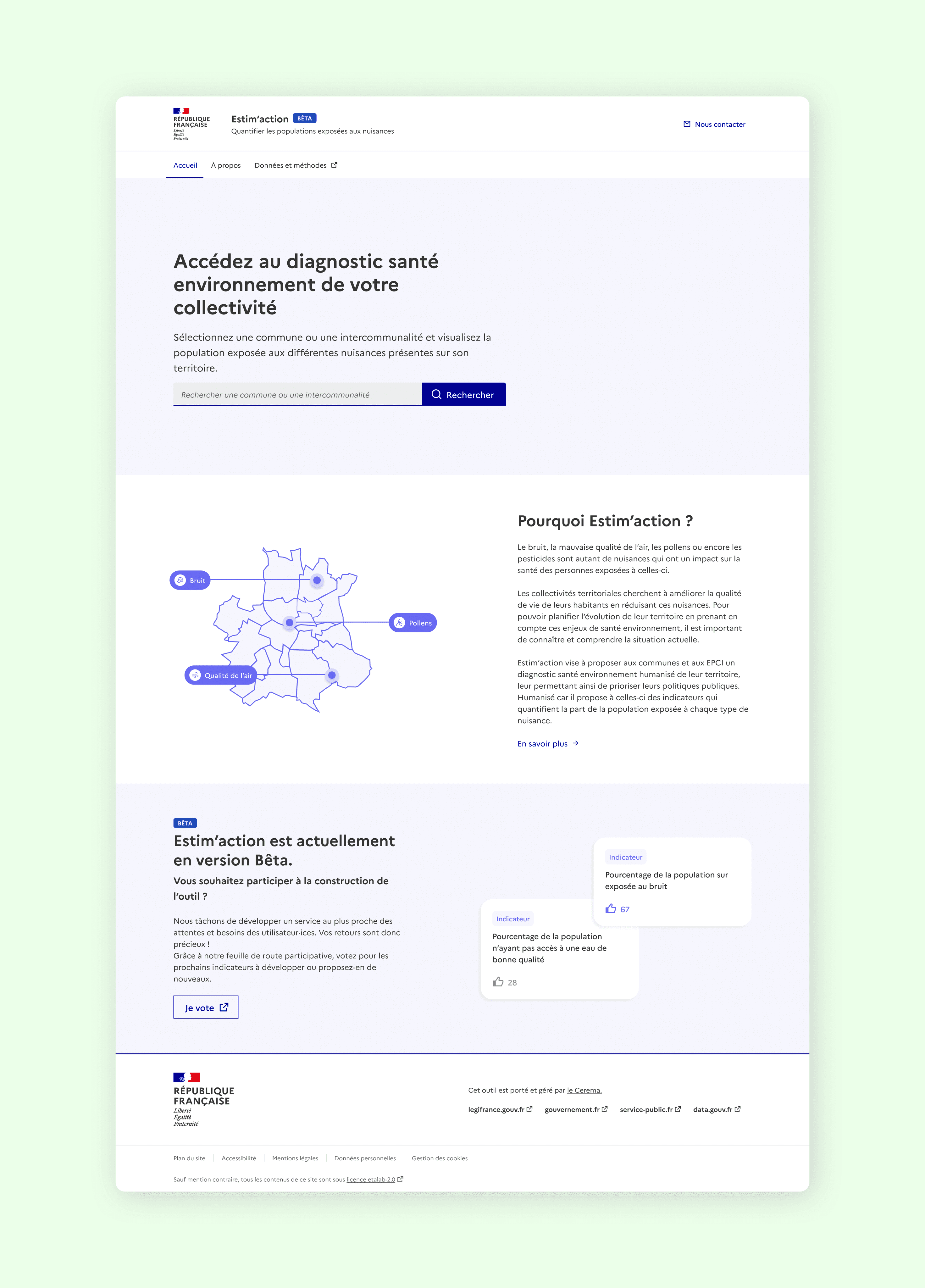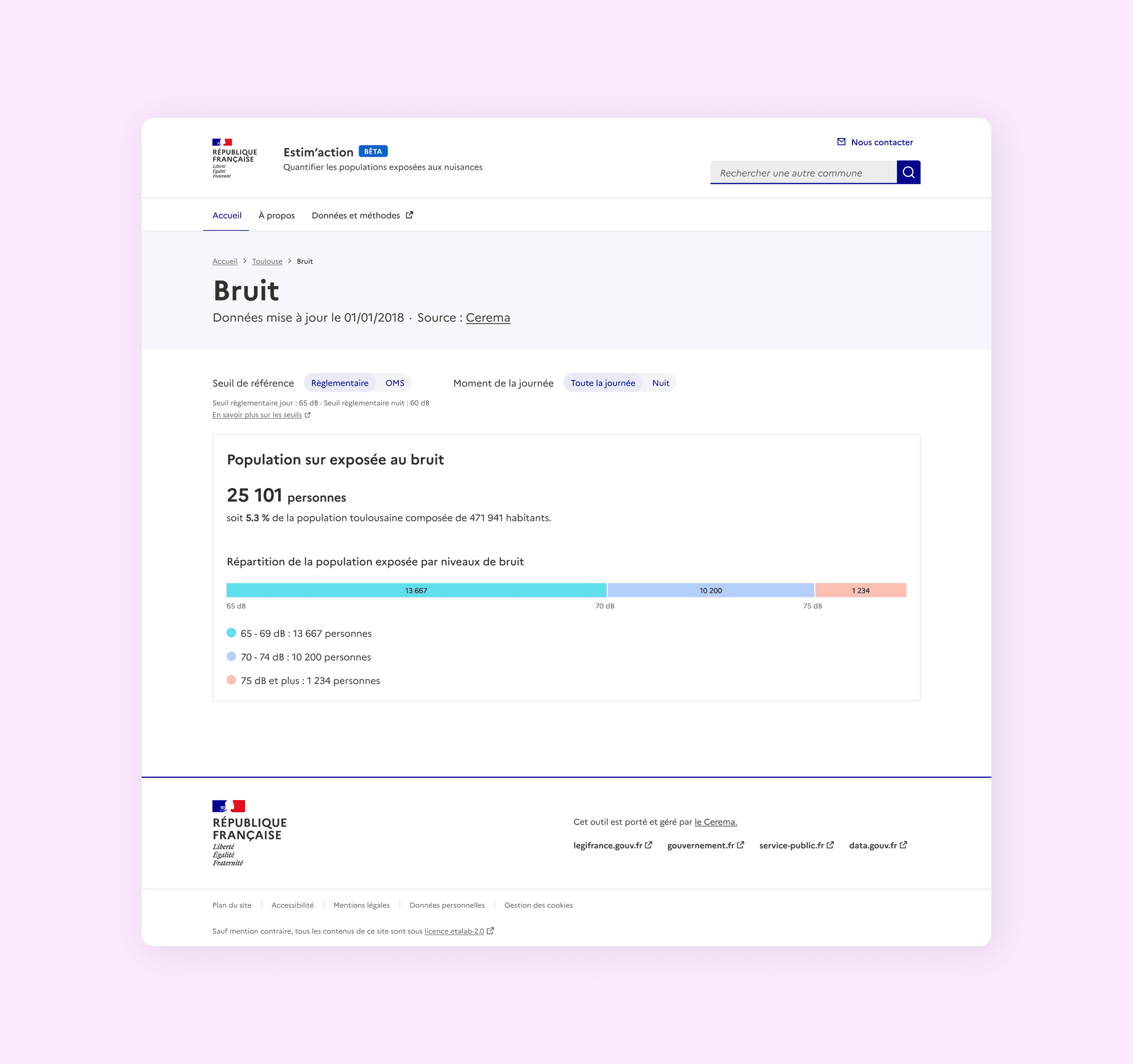Estim'action
Leading a project to develop a digital solution offering cities in France an environmental health diagnosis of their territory.
Team
Jeremie Letonnelier (data engineer) and Marion Caron (me)
Role
Product management, user research, UX, UI, communication
Year
2022 — 2023
Context and summary
Endorsed by the Cerema, this project was part of the EIG program created and animated by the DINUM, a French government entity. Participating teams are given a 10-month timeframe to create a solution on a given subject using an entrepreneurial approach.
Our challenge was to develop a tool to 'help cities to diminish pollution (air and noise) induced by car traffic and affecting people's health.'
Upon extensive research to comprehend the problems faced by users and after reframing the initial issue, we settled on a the concept to be developed — a digital dashboard providing a personalized and humanized environmental health diagnosis for each city in France.
The first version of our product (the MVP) is a dashboard that showcases indicators quantifying the population exposed to each type of pollution — for instance, 'the proportion of Parisian residents over exposed to noise.'
I know case studies can be long to read so feel free to jump on a particular section of your interest with the following hashtags:
Research
When arriving on the mission, we were only given the following issue to work on: "help cities to diminish pollution (air and noise) induced by car traffic and affecting people’s health”
The problem was broad, not well-defined and no investigation had been carried out. Consequently, our initial step was to start with an exploratory research phase. This essentially involved:
Meeting with 11 users
To understand the issues they are facing and what they need.
-> 1 hour interviews, based on a prepared interview guide
Meeting with 12 experts
To broaden our knowledge about air quality, noise, traffic, environmental health…
-> 1 hour discussions, based on some prepared questions but free format overall
Taking a look at the existing
To discover what was already created and understand a bit more the context.
-> benchmarking and lots of reading
During this research phase, we quickly noticed that, before deciding upon the actions to put into place to reduce the different pollution that can affect citizen's health in cities or towns, people working on those topics usually start by creating some kind of diagnosis of of the area in question.
Indeed, it is easier to decide where and how to act when knowing where the problems are located and how intensely they affect people.
Yet, creating those diagnoses proved to be arduous and painful.
Here are our main findings about them
Time
It takes time to gather all environmental health data as they are produced by different players and scattered everywhere.
Up to date
It's hard to ensure the data collected are the most recent ones.
Relevance
What constitutes a good indicator is debatable — it should be relevant but also convincing.

Mission officer in air quality
during a user interview
We came across environmental health diagnoses initiated by various urban areas, detailing pollution that can be found on their territory and their impact on the health of exposed individuals. Those documents —when existing— are great, but they usually comes in a non-editable PDF format, that cannot be updated easily and swiftly becomes outdated.
Design principles
After concluding the initial investigation phase, we established principles based on our discoveries and reflecting how we wanted to manage the project. These were designed to guide us throughout the conception, helping us maintain focus on what we wanted to achieve when taking decisions.
Centralized
All data available in one place
Humanized
People centered
Reliable
Accessible and up to date data
Standardized
Same tool and indicators for all cities
Iterative
Based on users feedback and new available data
Open source
Open to external contributions
Concept
We had our insights and principles. Now it was time to define the solution we were to build, in other words: our concept.
To do so, we organized a workshop with all the project's stakeholders to generate as many ideas/concepts as we could based on our research findings. I created a template to fill in for each suggested concept.
After that, we categorized the concepts we came up with (21!) according to their theme — fortunately, many of them were similar, simplifying the process. We deliberated over these organized groups collectively and selected the key concept to retain and develop based on several factors:
Use cases were identified for it
Technically speaking, it appeared feasible
Efforts to realize similar solutions had already been intended, demonstrating a genuine need for this
And that’s how we decided to conceive a digital dashboard providing a personalized and humanized environmental health diagnosis for each city in France.
We crash-tested that concept with users that had shown great interest about the project during our exploratory user research phase to ensure it made sense and we were still on the right track.
Minimum Viable Product
After selecting our concept, it was crucial to determine our starting point as well as our Minimum Viable Product (MVP).
Therefore, we compiled a list of all the features that seemed interesting to us, based both on our research findings and own personal creativity. We then engaged in a discussion about these and prioritized them primarily based on:
What would bring the most value to our users
What was feasible technically
What could be achieved in that short span of time
We ended up with a board outlining what our Alpha version (a technical proof of concept) and Beta version (MVP) would be. We also listed all the other ideas we had and might want to prioritize later on.
Once this was done, we also put into place a collaborative roadmap to gather insights from our users. We created a Trello board where they could vote for their desired features and indicators. They could also suggest new ideas that were not yet listed.
UI
I crafted the MVP on Figma, using the DSFR, the design system of the French government. The primary screens are visible below.
Communication
Embarking on an entrepreneurial journey likewise implies taking on responsibilities that don’t necessarily match one's professional expertise (speaking for myself, design).
For example, one problem we encountered was that, when meeting with new stakeholders, interested users, or potential partners, we lacked an effective way of maintaining connections and share updates regarding the project.
To counter that, I designed and no coded a landing page for Estim'action using Framer, granting interested individuals the opportunity to subscribe to our newsletter.
This newsletter served two main objectives: keeping subscribers informed about the project and soliciting help when necessary (for filling in surveys, participating to user testing sessions, and so on).
It worked pretty well as, even though our topic is quite niche, we reached 120 subscribers in a couple of weeks. If you feel like it, you can read our first newsletter (in French, sorry).
I also had the opportunity to pitch the project in front of large crowds in places such as the Ministry of the Ecological Transition and the Direction Interministérielle du Numérique (DINUM), driving interest towards what we were doing.
Takeaways
This project gave me the opportunity to lead the entire design side of it — all the way from exploratory user research to delivering the final UI of the MVP.
More than that, it also pushed me to expand beyond my design skills and do things such as managing a project from scratch, formulating and supporting a vision for it, presenting it to large audiences, writing a newsletter, no coding a website…
I won't deny, the adventure presented multiple challenges.
Firstly, only two of us with very limited resources (budget and time) were working on the project. Second, the problem we addressed —helping cities to reduce pollution— was very broad and we were given no guidelines to determine our starting point or direction. Last but not least, we were collaborating with an administration unfamiliar with the development of user-focused products, let alone rapid iterative methodologies.
Regardless, I will remember this entrepreneurial journey as a great ride where I enjoyed the freedom of it all. I'm also pleased by the concept we came up with and the ensuing MVP designed.
While pitching the initiative at major events, we encountered enthusiastic feedback from individuals dedicated to reducing pollution in cities. Some public administrations also proactively offered to contribute to our product.
It demonstrated a strong interest from the community and definitely provided motivation to keep on going!

Mission officer in environmental health and pollution
in one of our survey
This website has been designed and coded by Marion Caron
Copyright © Marion Caron, 2024






